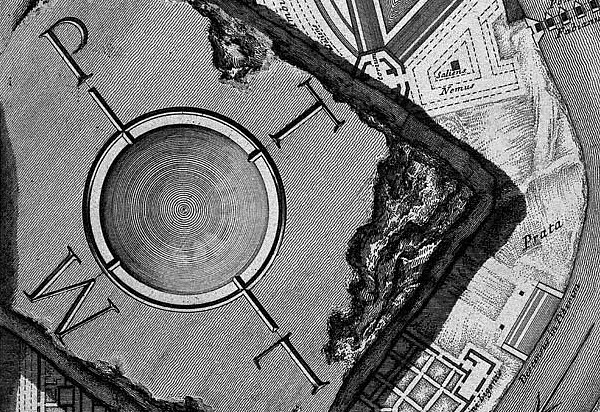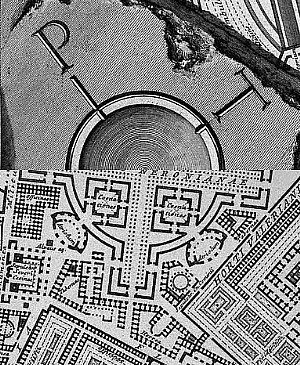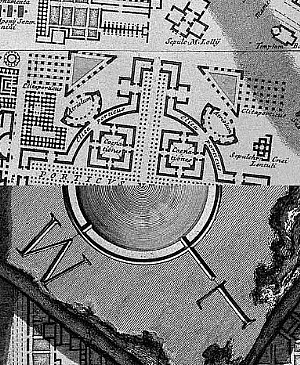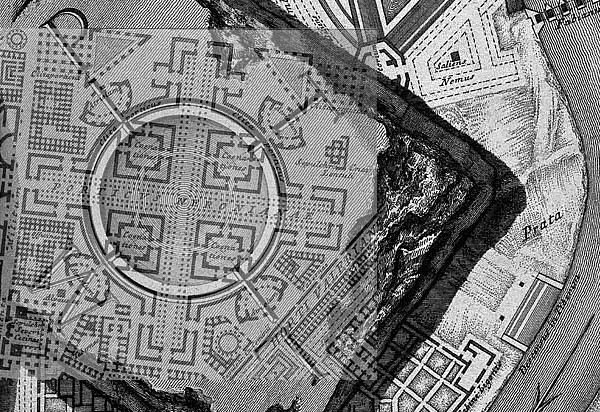The paper concludes, moreover, that the making of the Campo Marzio interpretively re-enacts the original imaginative founding of the Eternal City and, as such, constitutes an attempt to re-found Heroic Rome.
R. James Aitken, "PIRANESI - VICO - Il Campo Marzio: Foundations and the Eternal City" (McGill University: Master's Thesis, 1995.07.17)
excerpts:
Introduction: The Question of Meaning
p. 1:
On the other hand, we must not presume that the truth of Piranesi's work can be uncovered: at best we can gain a measure of access to its essential nature with a courteous reading of the documents.1 This means, among other things, preserving the mystery inherent in the work, even as we bring it forward to our own time. We can never fully explain the work, but we can construct an image of it for ourselves: one that will be meaningful (because we have made it for ourselves); and yet one that responds authentically and sincerely to the documents or artifacts at hand.
1The notion of courtesy as a theory of reception in reading any text, not only historical documents, is expounded by George Steiner explicitly in Real Presences, (Chicago, 1989), and implicitly under the notion of "translation" in After Babel, (Oxford, 1975). The courteous reader grants that the author--or more precisely the text--cannot be held to subscribe to the same assumptions, views and values as the reader himself. Paul Ricoeur addresses this issue throughout his writings, both in relation to texts and the historical past, in all cases balancing the meaningful access we have to these with the inaccessible and mysterious residue which we can approach only analogically--through narrative and the imagination.
p. 2:
I have employed two tactics by which to gain imaginative access to the Campo Marzio. One draws from the current work of Paul Ricoeur and George Steiner concerning theories of reading, reception and interpretation. The other engages the assistance of the Neopolitan philosopher Giambattista Vico. Vico is doubly appropriate in this regard as not only Piranesi's near contemporary and a sympathetic interpretive key for his work, but also as a forebear to the work of Ricoeur.
p. 3:
This paper began as an exercise in interpretation, reading the Campo Marzio by way of the New Science. As it turns out, these two works are themselves about interpretation, the making of meaning. Thus the study became an exercise in what it was about. The making of meaning begins with questioning and proceeds by way of the exercise of interpretation. Meaning does not exist as a given static correspondence between things and concepts, but is something actively made.
p. 3:
The two main contributions of this paper to the study of the Campo Marzio came by way of establishing its correspondences to Vico's concept of the Ideal Eternal History. On the one hand it unfolds a wholly contextual view of the work which incorporates, for the first time, all of its components including the introductory text. On the other, it supports this view and the correspondences to the Ideal Eternal History with a detailed examination rooted in the specific evidence of the text and plates. Piranesi's actual relationship to Vico is speculative and circumstantial. Although this study is not the first to infer a relationship between the two based on the Campo Marzio, it is the first to pursue it to this level of detail.
Chapter One: Pre-Figuration
A. The Limits of Reason
p. 4:
This is, first and foremost, an attempt to get "inside" the work, to discover and disclose the internal structures and relationships in the terms posited by the work itself. While this means working directly with the evidence of the work at hand, these documents must be understood as situated in a particular historical context and intellectual climate. While background information such as this contributes to the description and explanation of the work, it must not be misconstrued as the meaning of the work.
These analyses, seeking to expose the underlying content of the work, contribute to the explanation or description of the work, but not to its interpretation.
.1 Historical Context
Epistemological Shifts
p. 5:
Traditional teaching, dominated by the church-oriented universities, promoted rhetoric, the imagination, memory, and allegorical-symbolic thinking as the means to cope with our remoteness from the truth. Modern teaching in the independent academies presumed that the truth was present in our own realm and, though currently obscured, ultimately attainable. It replaced the inductive thinking of rhetoric and the imagination, designed to extend towards a remote truth, with deductive scientific reasoning designed to recover a truth hidden in our midst.
Not only were Vico and Piranesi conscious of this shift, but much of their work is predicated on trying to come to terms with it.
p. 9:
Vico's aim is not to recover the specifics of ancient traditions, but to restore the importance of their wholeness, and to reconstruct a whole relevant to his own time.
By the Romantic era at the end of the eighteenth century, holistic concepts of knowledge and the imagination had refracted and polarized, leading to the simultaneous emergence of art and science as the separate disciplines we know today. In the era of Vico and Piranesi this split, though imminent, was not yet complete. The modern paradigms present in the debate were not yet entrenched as presumed truth, but still in flux and open to challenge.
Il Campo Marzio
p. 11:
Within the more specific context of Piranesi's oeuvre, the Campo Marzio was published in 1762 at the midpoint of his productive career, which began in 1743 with the Prima parte di Architetture e Prospettive. It follows his work on the Nolli map of 1748 which produced a precisely-surveyed overall view of the Campo Marzio as it then stood. Between the Nolli map and the Campo Marzio Piranesi produced his archeological opus, the Antichitŕ Romane, published in four volumes from 1752 to 1756. The large six-plate ensemble in the Campo Marzio known as the ichnographia was produced shortly thereafter (according to the title block). Considered by some to be the fifth volume the Antichitŕ Romane, the Campo Marzio actually elevates the finding of the Antichitŕ to another level. Publications contemporary with the Campo Marzio include several archaeological works similar to the Antichitŕ as well as his 1761 re-visit to the Carceri, which had first been published around 1749-50.
The Campo Marzio consolidates his view on history, architecture, and the controversies of the day, prefiguring the debates and arguments developed in the subsequent Parere su l'Architettura (1765) and Diverse Maniere... (1796). Although the letterpress text of the Campo Marzio is fairly non-contentious, the publication as a whole ranks as one of his most polemical.
| |
.3 Existing Analyses
p. 13-14:
The text [of the Campo Marzio], with rare exceptions is ignored or dismisssed.
Chapter Two: Con-Figuration I
A. Imagination
p. 26:
The most significant poetic character though, is Rome, urbis, the Eternal City. In the Campo Marzio Piranesi reconstitutes mythical Rome as a fabulous truth, again in the same manner the primitive mind fashioned Jove: out of fragmentary bits of real stuff. The result is a Rome that is more true than an archaeologically reconstructed one. Still archaeological precision was important to Piranesi. On the one hand it provided a full and detailed cataloguing and description of the remains of antiquity which had to be respected. At the same time, it thoroughly exhausted the explanatory potential of the remains without sufficient results, demonstrating the necessity of interpretation to imagine the whole from which they came.
.2 Poetic Instruments
p. 32-33:
In the Campo Marzio Piranesi represents the templum as a compass retaining both meanings of orientation and boundary (to encompass). This reading is reinforced by the inscription on the compass tablet (which actually refers to the tablet lying on top of it):
Topographia Romae Longitudinum Campi Marti Adusque Pontem Milvium Demonstrans
One of the intents of the Campo Marzio is set out in the first chapter of the text entitled "Of the Location and the Original Extent of the Campo Marzio." Extension of the traditional bounds of the Campo Marzio to encompass the Milvian Bridge incorporates into the story of Rome the site where Constantine's transformation to Christianity occurred in AD 312. Piranesi's text actually ends at the fall of the empire (as he said it would in his opening sentence), prior to the birth of Constantine. However the final paragraph (Ch.6 ~XVIII) discussing the year of Rome 1023 (AD 270, the approximate birth of Constantine) speaks of the tempio al Buon Evento, which he locates in the center of plate VII of the Ichnographia. Could the birth of Constantine (and Roman Christianity) be the good event (event in the sense of accident, fortune, fate as opposed to mere occurrence) in the midst of human corruption and the fall of the empire?
The directional indices T-M-P-L suggest templa, however their use is fairly conventional [37: Only in plate I of the Campo Marzio does Piranesi use other references for the cardinal points: Orient in place of Pončnte, Occident in place of Levante, and Septemtrione in place of Tramontane. Septemtrione are the seven ploughing oxen in the constellation of the great bear which is associated with the north star of tramontane. It is the more common word for north, although Piranesi is not unique in his use of tramontane.] Tramontane, literally "between the mountains", is the name of the north wind or the north star as seen over the Alps. Meridióne is south, from the Latin meridianis for midday in the sky. Pončnte is west or the west wind, possibly from the Latin ponere "to put, or set down" in relation to the setting sun, while Levante is east, possibly from levare "to raise" in relation to the rising sun.
Chapter Four: Re-Figuring
p. 89:
When we consider the Campo Marzio from the point of view of its author, it may be about several things:
a) the Ideal History of Rome
b) the appropriateness of Rome as the authoritarian model for cities and architecture, and/or
c) a warning of imminent danger inherent in modern rational-skeptical thinking.
While these may be valid readings, they limit discussion to internal examination of these issues. If, on the other hand, we consider the Campo Marzio from the point of view of what it is, for us, independent of the author's presumed intentions or message, then an authentic interpretation of the work emerges. Such an interpretation describes, for us, what the work really appears to be, aside from any encoded messages. Only when we grasp it as such can the work begin to speak to us.
The Campo Marzio, in these terms, appears to be a demonstration of imagination and practice as founding-inauguration activities. Imagination or interpretation, exercised within a bounded field of multiple possibilities, actualizes the particular historical ground of a nation or culture. This exercise of the founding imagination, in or upon the world of experience, is the nature of architectural practice.
A. Plenitude and Dialectics
p. 91:
In the Campo Marzio this complex intertwining of past and present, diachronic and synchronic, is generally represented in the ichnographia where Piranesi extracts the Ideal Eternal City from the landscape and fragmentary remains. On the ground constituted by these situated ruins the ichnographia creates a figure which enfolds the various ages into a larger configuration that preserves and sustains them complete with their internal differences and dialectics. The power of the ichnographia is this enfolding capacity by which it accommodates conflicting elements and opens itself up to multiple readings. This power and its ability to support multiple narratives is also the source of its misappropriation by various readers, a misappropriation which is not an error: merely a partial reading.
B. Fundamental Practice:
p. 94-95:
Piranesi employs them, too, in his reconstruction of Rome in the Campo Marzio: an imaginative construction that is neither an ideal nor a fantasy, neither fact nor fiction, but a factum that captures and re-presents the essential Rome as revealed in his configuration of the fragments. This factum, as a re-making of Rome, lies midway between the verum and the certum. As an approximation of truth, constructed in the certum out of actual remains, it reveals what we can know of Rome. This re-creation re-enacts the original founding process, and is essentially a poetic re-founding of Rome on an imaginatively constructed ground, a ground which mediates the verum-certum in a particularly Latin-Roman-Heroic way.
| |
1997.07.25
Vico and the Campo Marzio
from: Patrick L. Gardiner, "Philosophy of history" in Encyclopedia Britannica (Chicago: Encyclopedia Britannica, 1969), vol. 11, p. 543.
Giambattista Vico's Scieza nuova (1744) was a work whose importance remained for a long time unrecognized, partly, no doubt, because of the obscure and scholasic manner in which the Italian philosopher expressed his ideas. Central to the book is the contention that the kind of knowledge which men can achieve of their own actions, creations, and institutions--the material of history--is of a radically different kind from the knowledge that is acquired by the observation and investigation of the nonhuman or "natural" world: indeed, knowledge of the former type is of a superior or "more certain" character. In order truly to know something it is necessary in some sense o have made it, and where as the reality which the physical scientist studies is the creation of God and therefore only properly known to him, "the world of nations" that forms the subject matter of history is the creation of men and is therefore something that men can "hope to know." Thus Vico was led to stress the differences rather that the analogies between historical and other forms of inquiry and laid emphasis upon the need for the historian to recreate imaginatively the spirit of the past ages and the outlook and attitudes of mind possessed by the men who lived in them, instead of trying to impose upon them inappropriate interpretive models--"Pseudomyths"--suggested by ways of thinking and feeling current in his own time. It is true that Vico pronounced a cyclical theory of human history, according to which "nations" or cultures pass through determinate stages: he employed it, however, in a manner that underlined man's nature as a historical being, whose powers and capacities do not conform to a fixed and static pattern but are subject to change and development in the course of time: it is not through a priori intuition ot through attention to the subjective findings of introspective self-consciousness that we can acquire the depest insight into what we are (as so many of his contemporaries assumed), but through a critical and sympathetic interpretation of the evidence provided by historical research.
This quote brings to mind Piranesi's Campo Marzio as an imaginative recreation of the spirit of past Roman ages. Relating it to Piranesi, however, is like being on a double-edged sword--a thin line between being too imaginative and going beyond contemporary modes of interpretation. Did Piranesi totally avoid the interpretive methods current in his time.
Is Aitken's thesis something along these lines?
2001.01.04
sixth architectural reference
R. James Aitken, Piranesi-Vico-Il Campo Marzio: Foundations and the Eternal City (Montreal: McGill University, 1995). This is Aitken's Master of Architecture thesis.
I first became aware of Aitken's thesis in late 1996 via an online publication of the thesis' abstract [www.mcgill.ca /arch /theory /marchabs .htm]. I did not read the thesis, however, until July 2000, that is, immediately after ordering the thesis through www.contentville.com [I just did a check at contentville and Aitken's thesis is oddly nolonger available there]. It was then that I again read the abstract and saw that Aitken's had already connected the notion of reenactment with Piranesi's large plan of Il Campo Marzio. What distressed me was that I had been by that time making much ado about Piranesi's Campo Marzio being a reenactment of the Pagan-Christian inversion of ancient/imperial Rome, yet I was doing so without any reference to Aitken's thesis. Of course, I really could not make any reference to Aitken's work simply because I had not read it, but that does not excuse the lacuna of my research and analysis. Henceforth, let it be clear that R. James Aitken is the first architect to identify Piranesi's Ichnographia Campi Martii as a reenactment.
Aitken also picks up on Piranesi's clues that the Campo Marzio is about Pagan Rome's conversion to Christianity, again a topic that I have been keen on. As with reenactment, however, Aitken is somewhat timid about his convictions in these regards, for the bulk of his thesis deals with the clear possible connection between Vico's "philosophy" and Piranesi's method. Plus Aitken stresses a reading of the Campo Marzio text along with a 'reading' of the large plan. In all, Aitken's thesis is very good, full of many valuable insights, and arguably the first full study of the Campo Marzio done with regard to the context of Piranesi's own time. Aitken's thesis does not follow Manfredo Tafuri's analyses of the Campo Marzio (as do Bloomer, Eisenman, and others), and thus Piranesi-Vico-Il Campo Marzio does not follow in the mistaken interpretations that Tafuri initiated.
With regard to my Campo Marzio research and 'thesis', it is somewhat uncanny that Aitken and I arrive at virtually the same conclusions, yet we come to the conclusions from distinctly different means. In fact, when you compare Aitken's thesis with the Campo Marzio material formerly published at www.quondam.com, our respective works virtually never repeat each other. Taken together, however, a new and cohesive understanding of Piranesi's Campo Marzio emerges.
2002.10.26 13:55
research assisance
2655
| |
2007.09.08
"The directional indices...

"The directional indices T-M-P-L suggest templa, however their use is fairly conventional. Tramontane, literally "between the montains", is the name of the north wind or the north star as seen over the Alps. Meridióne is south, from the Latin meridianis for midday when Dianus, god of light and the sun, and male counterpart of Diana, is highest in the sky. Pončnte is west or the west wind, possibly from the Latin ponere "to put, or set down" in relation to the setting sun, while Levante is east, possibly from levare "to raise" in relation to the rising sun."
--R. James Aitken, Piranesi-Vico-Il Campo Marzio: Foundations and the Eternal City.
 
"...the inner circle of the Porticus Neronianae matches the circle of the compass/north arrow that Piranesi also delineated within the Ichnographia."

"The end of Livy Book 5 describes the rebuilding of Rome in the wake of the Gallic sack. The Romans were in a great hurry to rebuild, he writes, and for this reason there was no order to the new city, so that forma . . .urbis sit occupatae magis quam divisae similis, 'the arrangement of the city resembles that of a place taken over rather than portioned out'. Occupata here may be read as evoking Rome's recent occupation by the Gauls. Kraus draws our attention to Tacitus' reading of this Livian episode, which the latter author makes use of in his account of the destruction of Rome in the Neronian fire and the city's subsequent rebuilding. Tacitus' account presents Nero's fire as worse than the Gallic sack, for it causes destruction of monuments witnessing the origins of Rome. Rome is then rebuilt; large areas in the centre of the city are taken over for Nero's Domus Aurea. Nero's appropriation of the city is like that of a foreign enemy."
--Catharine Edwards, Writing Rome: textual approaches to the city.
|



